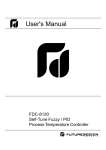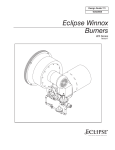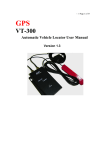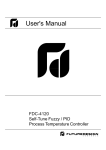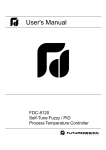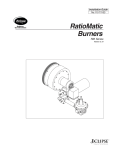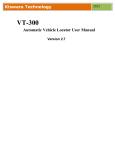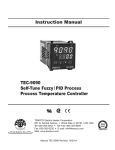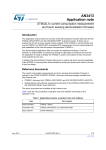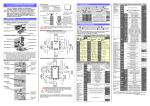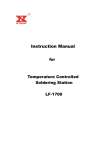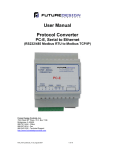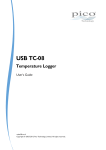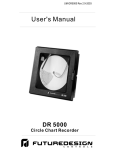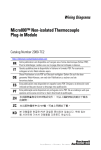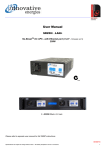Download User`s Manual - BURNERPARTS.com
Transcript
User's Manual FDC-9090 Self-Tune Fuzzy / PID Process / Temperature Controller Warning Symbol This Symbol calls attention to an operating procedure, practice, or the like, which, if not correctly performed or adhered to, could result in personal injury or damage to or destruction of part or all of the product and system. Do NOT proceed beyond a warning symbol until the indicated conditions are fully understood and met. Use the Manual Specifications Page 3 Wiring Page 4 Programming Page 5 NOTE: It is strongly recommended that a process should incorporate a LIMIT like L91 which will shut down the equipment at a preset process condition in order to preclude possible damage to products or system. Copyright a August 2001, Future Design Controls, all rights reserved. No part of this publication may be reproduced, transmitted, transcribed or stored in a retrieval system, or translated into any language in any form by any means without the written permission of Future Design Controls. 2 UM9090Rev1 C Model:FDC 9090 Instruction Manual 3. FRONT PANEL DESCRIPTION CONTENTS 1. INTRODUCTION 2. NUMBERING SYSTEM 3. FRONT PANEL DESCRIPTION 4. INPUT RANGE & ACCURACY 5. SPECIFICATIONS 6. INSTALLATION 6.1 DIMENSIONS & PANEL CUTOUT 6.2 WIRING DIAGRAM Set point Value Display (0.3" green LED) PV 7. CALIBRATION 8. OPERATION 8.1 KEYPAD OPERATION 8.2 FLOW CHART 8.3 PARAMETER DESCRIPTION 8.4 AUTOMATIC TUNING 8.5 MANUAL P.I.D. ADJUSTMENT 8.6 MANUAL TUNING PROCEDURE 8.7 RAMP & DWELL Control Output CON Alarm Output ALM Process Value Display (0.4" red LED) SV Down Key Scroll Key Return Key 9. ERROR MESSAGES 1. INTRODUCTION This manual contains information for the installation and operation of the Future Design Control’s model FDC-9090 Fuzzy Logic micro-processor based controller. The Fuzzy Logic is an essential feature of this versatile controller. Although PID control has been widely accepted by industries, it is difficult for PID control to work with some sophistic systems efficiently, for example, systems of second order, long time-lag, various set points, various loads, etc. Because of disadvantage of controlling principles and fixed values of PID control, it is inefficient to control the systems with many variables and the result is unacceptable control for some systems. The Fuzzy Logic control can overcome the disadvantage of PID control only. It controls the system in a efficient way by experiences it had before. The function of Fuzzy Logic is to adjust the PID values indirectly in order to making the manipulation output value MV adjusts automatically and quickly to adapt to various processes. It enables a process to reach its set point in the shortest time with minimum overshooting during tuning or external disturbance. PID+FUZZY CONTROL MV SYSTEM Temperature + Warm Up Input Type Iron-Constantan Chromel-Alumel Copper-Constantan Chromel-Constantan Pt30%RH/Pt6%RH Pt13%RH/Pt Pt10%RH/Pt Nicrosil-Nisil PT100 ohms(DIN) PT100 ohms(JIS) -10mV to 60mV Range( BC ) -50 to 999 BC -50 to 1370 BC -270 to 400 BC -50 to 750 BC 300 to 1800 BC 0 to 1750 BC 0 to 1750 BC -50 to 1300 BC -200 to 400 BC -200 to 400 BC -1999 to 9999 Accuracy A2 BC A2 BC A2 BC A2 BC A3 BC A2 BC A2 BC A2 BC A0.4 BC A0.4 BC A0.05% Load Disturbance + PID PV _ + SV FUZZY In addition, this instrument has functions of single stage ramp and dwell, auto-tunung and manual mode execution. Ease of use also an essential feature with it. 2. Model Order Matrix (1) (2) (3) (4) (5) (6) (7) (8) (1) Power Input 4 90-264VAC 5 20-32VAC/VDC 9 Other (2) Signal Input 5 Configurable (Universal) 9 Other (3) Range Code 1 Configurable 9 Other (4) Control Mode 3 PID / ON-OFF Control (5) Output 1 Option 0 None 1 Relay rated 3A/240VAC resistive 2 SSR Drive rated 20mA/24V 3 4-20mA linear, max. load 500 ohms (Module OM93-1) 4 0-20mA linear, max. load 500 ohms (Module OM93-2) 5 0-10V linear, min. impedance 500K ohms (Module OM93-3) 9 Other (6) Output 2 Option 0 None (7) Alarm Option 0 None 1 Relay rated 2A/240VAC resistive 9 Other (8) Communication 0 None type J, K, T, E, B, R, S, N. PT100 ohm RTD (DIN 43760/BS1904 or JIS) -10 to 60 mV, configurable input attenuation Thermocouple (T/C): User configurable, refer to Table above RTD: Refer to Table above Linear: 0.1 BC/ BC ambient typical Range: Protection mode configurable Accuracy: Cold Junction Compensation: 100 ohms max. 60 dB Sensor Break Protection: 120dB External Resistance: 3 times / second Normal Mode Rejection: Common Mode Rejection: Sample Rate: INPUT Time FDC IN Sensor 0 J K 1 T 2 3 E 4 B 5 R 6 S 7 N 8 RTD 9 RTD 10 Linear 5. SPECIFICATIONS PID control with properly tuned PID + Fuzzy control Set point Up Key 4. INPUT RANGE & ACCURACY CONTROL Proportion Band: Reset ( Integral ): Rate ( Derivative ): Ramp Rate: Dwell: ON-OFF: Cycle Time: Control Action: 0 - 200 BC ( 0-360BF) 0 - 3600 seconds 0 - 1000 seconds 0 - 200.0 BC /minute (0 - 360.0 BF /minute) 0 - 3600 minutes With adjustable hysteresis (0-20% of SPAN) 0-120 seconds Direct (for cooling ) and reverse (for heating) POWER Rating: Consumption: 90-264VAC, 50/ 60Hz Less than 5VA ENVIRONMENTAL & PHYSICAL Safety: EMC Emission: EMC Immunity: Operating Temperature: Humidity: Insulation: Breakdown: Vibration: Shock: Net Weight: Housing Materials: UM9090Rev1 UL873, CSA22.2/142-87, IEC1010-1 (EN61010-1) EN50081-1 EN50082-2 -10 to 50 BC 0 to 90 % RH (non-codensing) 20M ohms min. ( 500 VDC ) AC 2000V, 50/60 Hz, 1 minute 10 - 55 Hz, amplitude 1 mm 2 200 m/ s ( 20g ) 170 grams Poly-Carbonate Plastic 3 6. INSTALLATION 7. CALIBRATION 6.1 DIMENSIONS & PANEL CUTOUT Note: Do not proceed through this section unless their is a genuine need to re-calibrate the controller. All previous calibration date will be lost. Do not attempt re-calibration unless you have available appropriate calibration equipment. If calibration data is lost, you will need to return the controller to your supplier who may apply a charge for re-calibration. (45 mm) 1.77 “ (45 mm) 1.77 “ Prior to calibration ensure that all parameter settings are correct (input type, BC / BF, resolution, low range, high range). 1. Remove sensor input wiring and connect a standard input simulator of the correct type to the controller input. Verify correct polarity. Set simulated signal to coincide with low process signal (e.g. zero degrees). 2. Use the Scroll Key until the " Display. (Refer to 8.2) Panel 3.38 “ 86 mm 3.70 “ 94 mm Figure 6.1 Mounting Dimensions 3. Use the Up and Down Keys until the SV Display represents the simulated input. 4. Press the Return Key for at least 6 seconds(maximum 16 seconds), then release. This enters the low calibration figure into the controller's non-volatile memory. 5. Press and release the Scroll Key. " " appears on the PV Display. This indicates the high calibration point. 6.2 WIRING DIAGRAM 6. Increase the simulated input signal to coincide with high 11 process signal (e.g. 100 degrees). FDC-9090 Alarm Com. Alarm N/O RTD _ _ + V + 1 2 3 4 5 6 7 8 9 10 S1 F1 90 - 264 VAC,50/60HZ + _ 7. Use the Up and Down Keys until the SV Display represents the simulated high input. 8. Press the Return Key for at least 6 seconds (maximum 16 seconds), then release. This enters the high calibration figure into the controller's non-volatile memory. Control Output 1 9. Turn power off the unit, remove all test wiring and replace sensor wiring (observing polarity). * F1: Fuse, S1: Power Switch 8. OPERATION 8.1 KEYPAD OPERATION * With power on, it has to wait for 12 seconds to memorize the new values of parameters once it been changed. TOUCHKEYS FUNCTION DESCRIPTION Scroll Key Advance the index display to the desired position. Index advanced continuously and cyclically by pressing this keypad. Up Key Increases the parameter Down Key Decreases the parameter Return Key Resets the controller to its normal status. Also stops auto-tuning, output percentage monitoring and manual mode operation. Press for 6 seconds Long Scroll Allows more parameters to be inspected or changed. Press for 6 seconds Long Return 1. Executes auto-tuning function 2. Calibrates control when in calibration level Press Output Percentage Monitor Allows the set point display to indicate the control output value. Manual Mode Execution Allows the controller to enter the manual mode. and Press and for 6 seconds UM9090Rev1 4 " appears on the PV 8.2 FLOW CHART PROCESS VALUE DISPLAY SET POINT VALUE DISPLAY 8.3 PARAMETER DESCRIPTION Level 0 Long (6 seconds) INDEX CODE SV **DEFAULT SETTING DESCRIPTION ADJUSTMENT RANGE Set point Value Control *Low Limit to High Limit Value Undefined Alarm Set point Value * Low Limit to High Limit Value.(if =0, 1, 4 or 5) * 0 to 3600 minutes ( if =12 or 13) * Low Limit minus set point to high Limit minus set point value ( if =2, 3, 6 to 11 ) Level 1 Ramp Rate for the process value to limit an abrupt change of process (Soft Start) * 0 to 200.0 BC (360.0 BF) / minute ( if = 0 to 9 ) * 0 to 3600 unit / minute ( if =10 ) Offset Value for Manual Reset ( if * 0 to 100% =0) Offset shift for process value * -111 BC to 111 BC Proportional Band * 0 to 200 BC ( set to 0 for on-off control) Integral (Reset) Time * 0 to 3600 seconds Parameter Selection ( allows selection of additional parameters to be accessible at level 0 security) , 0: None 4: 1: 5: 2: 6: , 3: 7: , , Input Mode Selection 0: J type T/C 6: S type T/C 1: K type T/C 7: N type T/C 2: T type T/C 8: PT100 DIN 3: E type T/C 9: PT100 JIS 4: B type T/C 10: Linear Voltage or Current 5: R type T/C Note: T/C-Close solder gap G5, RTD-Open G5 Alarm Mode Selection 0: Process High Alarm 1: Process Low Alarm 2: Deviation High Alarm 3: Deviation Low Alarm 4: Inhibit Process High Alarm 5: Inhibit Process Low Alarm 6: Inhibit Deviation High Alarm 7: Inhibit Deviation Low Alarm 8: Outband Alarm 9: inband Alarm 10: Inhibit Outband Alarm 11: Inhibit Inband Alarm 12: Alarm Relay OFF as Dwell Time Out 13: Alarm Relay ON as Dwell Time Out Hysteresis of Alarm 1 * 0 to 20% of SPAN BC / BF Selection 0: BF, 1: BC Long (6 seconds) Level 3 Power Applied: Displayed for 4 seconds. 1. (Software Version 3.6 or higher) 2. LED test. All LED segments must be lit for 4 seconds. 3. Process value and set point indicated. 0 BC 10 BC 30 sec. 1 0 T/C 0 RTD 8 Linear 10 0 0.5% 1 Resolution Selection 2: 2 Digit Decimal 0: No Decimal Point 3: 3 Digit Decimal 1: 1 Digit Decimal (2 & 3 may only be used for linear voltage or current =10 ) 0 Control Action 0: Direct (Cooling) Action 1 1: Reverse (Heat) Action Error Protection 0: Control OFF, Alarm OFF 2: Control ON , Alarm OFF 1: Control OFF, Alarm ON 3: Control ON, Alarm ON The "return" key can be pressed at any time. This will prompt the display to return to the Process value/Set point value. 0.0 % 20 Relay Pulsed Voltage 1 Linear Volt/mA 0 Proportional Cycle Time * 0 to 120 seconds Level 2 0 BC / min. 120 sec. Derivative (Rate) Time * 0 to 1000 seconds Local Mode 0: No control parameters can be changed 1: Control parameters can be changed Long (6 seconds) 200 BC 1 Hysteresis for ON/OFF Control *0 to 20 % of SPAN 0.5% Low Limit of Range -50 BC High Limit of Range 1000 BC Low Calibration Figure 0 BC High Calibration Figure 800 BC NOTES: * Adjusting Range of the Parameter ** Factory settings. Process alarms are at fixed temperature points. Deviation alarms move with the set points value. UM9090Rev1 5 8.7 RAMP & DWELL 8.4 AUTOMATIC TUNING 1. Ensure that controller is correctly configured and installed. 2. Ensure Proportional Band 'Pb' is not set at '0'. 3. Press Return Key for at least 6 seconds ( maximum 16 seconds). This initializes the Auto-tune function. (To abort auto-tuning procedure press Return Key and release). 4. The Decimal point in lower right hand corner of PV display flashes to indicate Auto-tune is in progress. Auto-tune is complete when the flashing stops. The FDC-9090 controller can be configured to act as either a fixed set point controller or as a single ramp controller on power up. This function enables the user to set a pre-determined ramp rate to allow the process to gradually reach set point temperature, thus producing a 'Soft Start' function. A dwell timer is incorporated within the FDC-9090 and the alarm relay can be configured to provide either a dwell function to be used in conjunction with the ramp function. 5. Depending on the particular process, automatic tuning may take up to two hours. Processes with long time lags will take the longest to tune. Remember, while the display point flashes the controller is auto-tuning. The ramp rate is determined by the ' ' parameter which can be adjusted in the range 0 to 200.0 BC/minute. The ramp rate function is disabled when the ' ' parameter is set to ' 0 '. NOTE: If an AT error( ) occurs, the automatic tuning process is aborted due to the system operating in ON-OFF control(PB=0). The process will also be aborted if the set point is set to close to the process temperature or if there is insufficient capacity in the system to reach set point (e.g. inadequate heating power available). Upon completion of Auto-tune the new P.I.D. settings are automatically entered into the controller's non-volatile memory. The soak function is enabled by configuring the alarm output to act as a dwell timer. The parameter needs to be set to the value 12. The alarm contact will now operate as a timer contact, with the contact being closed at power up and opening after the elapsed time set at parameter . 8.5 MANUAL P.I.D. ADJUSTMENT Whilst the auto-tuning function selects control settings which should prove satisfactory for the majority of processes, you may find it necessary to make adjustments to these arbitrary settings from time to time. This may be the case if some changes are made to the process or if you wish to 'fine-tune' the control settings. It is important that prior to making changes to the control settings that you record the current settings for future reference. Make slight changes to only one setting at a time and observe the results on the process. Because each of the settings interact with each other, it is easy to become confused with the results if you are not familiar with process control procedures. 75 Derivative Time (Rate) Symptom Slow Response or Oscillations High Overshoot Solution Decrease Deriv. Time Increase Deriv. Time ON Alarm Output OFF t(minutes) 0 10 20 30 40 50 60 70 80 90 The dwell function may be used to operate an external device such as a siren to alert when a soak time has been reached. need to be set to the value 13. The alarm contact will now operate as a timer contact, with the contact being open on the initial start up. The timer begins to count down once the set point temperature is reached. After the setting at has elapsed, the alarm contact closes. Step 1: Adjust the integral and derivative values to 0. This inhibits the rate and reset action Step 2: Set an arbitrary value of proportional band and monitor the control results Step 3: If the original setting introduces a large process oscillation, then gradually increase the proportional band until steady cycling occurs. Record this proportional band value(Pc). Step 4: Measure the period of steady cycling 9. ERROR MESSAGES Symptom Tc Cause (s) Solution (s) Sensor break error Replace RTD or sensor Use manual mode operation Process display beyond the low range set point Re-adjust value Process display beyond the high range set point Re-adjust value Analog hybrid module damage Replace module. Check for outside source of damage such as transient voltage spikes Incorrect operation of auto tune procedure Prop. Band set to 0 Repeat procedure. Increase Prop. Band to a number larger than 0 Manual mode is not allowable for an ON-OFF Increase proportional band control system TIME Check sum error, values in memory may have changed accidentally Step 5: The Control Settings are determined as follows: Proportion Band(PB)=1.7 Pc Integral Time (TI)=0.5 Tc Derivative Time(TD)=0.125 Tc 6 15 minutes 50 8.6 MANUAL TUNING PROCEDURE Record this value (Tc) in seconds Process Value 25 Solution Decrease Integral Time Increase Integral Time PV(Process value) BC 150 100 Solution Decrease PB Value Increase PB Value Integral Time (Reset) Symptom Slow Response Instability or Oscillations PV In the example below the Ramp Rate is set to 5 BC/minute, =12 and =15 (minutes). Power is applied at zero time and the process climbs at 5 BC/minute to the set point of 125 BC. Upon reaching set point, the dwell timer is activated and after the soak time of 15 minutes, the alarm contact will open, switching off the output. The process temperature will eventually fall at an undetermined rate. 125 TUNING GUIDE Proportional Band Symptom Slow Response High Overshoot or Oscillations If the controller power supply or output is wired through the alarm contact, the controller will operate as a guaranteed soak controller. UM9090Rev1 Check and reconfigure the control parameters A 2 Warranty WARRANTY Future Design Controls warranties or representations of any sort regarding the fitness for use, or the application of its products by the Purchaser. The selection, application or use of Future Design products is the Purchaser's responsibility. No claims will be allowed for any damages or losses, whether direct, indirect, incidental, special or consequential. Specifications are subject to change without notice. In addition, Future Design reserves the right to make changes without notification to Purchaser to materials or processing that do not affect compliance with any applicable specification. Future Design products are warranted to be free from defects in material and workmanship for two years after delivery to the first purchaser for use. An extended period is available with extra cost upon request. Future Design’s sole responsibility under this warranty, at Future Design’s option, is limited to replacement or repair, free of charge, or refund of purchase price within the warranty period specified. This warranty does not apply to damage resulting from transportation, alteration, misuse or abuse. RETURNS No products return can be accepted without a completed Return Material Authorization ( RMA ) form. UM9090Rev1 7 User's Manual FDC-9090 Process / Temperature Controller Burnerparts.com 2011 Williamsburg Road Richmond, Virginia 23231 Tel: 804-236-3881 Fax: 804-236-3882 [email protected] UM9090Rev1 7524 West 98th Place Bridgeview, IL 60455 Phone - 888-751-5444 Fax 888-307-8014 UM9090Rev1








